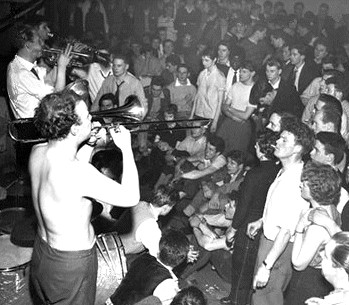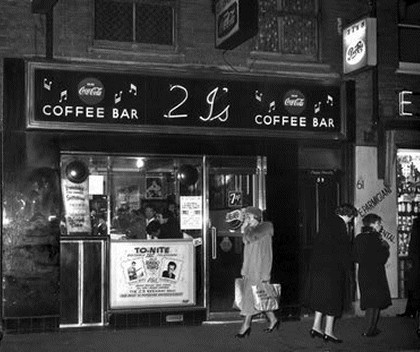Soho, a square mile in the heart of London, has long been synonymous with vibrant culture and groundbreaking music. From its humble beginnings as agricultural land to its current status as a bustling entertainment district, Soho’s evolution mirrors the changing rhythms of London itself. In the swinging sixties, this area became a melting pot for musical innovation, particularly in jazz and the burgeoning dance scenes that sprung up around it. This is a journey into the heart of London’s jazz dance clubs, exploring the venues that shaped a generation and continue to resonate today.
Soho’s story begins centuries before the electrifying energy of the 1960s. Originally fields and grazing land, it transitioned through royal ownership to a developing urban area in the 17th century. The name “Soho Fields” itself, possibly derived from a hunting cry, hints at the area’s early, more pastoral character. As London expanded, Soho attracted waves of immigrants, most notably French Huguenots, becoming known as the “French Quarter” in the late 1600s. While attempts to make it a fashionable residential area like Mayfair faltered, Soho cultivated a different kind of vibrancy, attracting artists, writers, and a more bohemian population.
 Soho Square, circa 1700
Soho Square, circa 1700
Image alt text: An artistic rendering of Soho Square in London circa 1700, depicting horse-drawn carriages and figures in period attire within a developing urban landscape.
By the 18th and 19th centuries, Soho’s character shifted further. Aristocrats moved out, but a new kind of cultural richness moved in. The area became known for its diverse inhabitants, small theatres, music halls, and a burgeoning nightlife. This evolution laid the groundwork for Soho’s 20th-century explosion onto the world stage as a music and entertainment epicenter.
The post-World War II era witnessed the birth of modern jazz in Britain, and Soho was at its very epicenter. Club Eleven, opening in 1948 at 41 Great Windmill Street, is often cited as the birthplace of this movement. Though short-lived, it was pivotal in developing bebop in the UK, featuring house bands led by jazz luminaries Ronnie Scott and Johnny Dankworth. These musicians, along with their colleagues, lent the club its name, “Club Eleven.” While its lifespan was brief, its impact on the trajectory of British jazz was immense, setting the stage for a vibrant club scene.
The 1950s saw a surge in smaller music venues and coffee bars, creating a fertile ground for emerging musical styles. The Daybreak Club, The 51 Club, and Cy Laurie’s Blue Heaven Club all contributed to this burgeoning scene. London’s first skiffle club, “The London Skiffle Centre,” opened in 1952 in The Roundhouse pub on Wardour Street, further diversifying the musical landscape of Soho. These venues were more than just places to listen to music; they became social hubs, fostering a sense of community among musicians and fans alike.
Studio 51, initially known simply as “The Studio,” became another crucial jazz venue. Owned by Vi Highland, it hosted various jazz nights featuring artists like Johnny Dankworth and Chris Barber. By 1951, under Joe Muddel’s musical direction, “Studio 51” became synonymous with modern jazz. The arrival of Ken Colyer in 1954 further solidified the club’s jazz credentials, although by the late 1950s and early 1960s, rhythm and blues began to take center stage. Even as musical tastes evolved, Studio 51 remained a vital space for live music in Soho.
 Cy Laurie Club 1956
Cy Laurie Club 1956
Image alt text: A vintage black and white photograph capturing the lively atmosphere inside the Cy Laurie Club in Soho, London, circa 1956, showcasing musicians performing jazz music to a packed audience.
The coffee bar revolution of the 1950s further fueled Soho’s musical energy. Inspired by Italian espresso culture, bars like Bar Italia and the Moka coffee bar sprang up, providing alcohol-free spaces that attracted a younger crowd eager for the new sounds. The 2i’s Coffee Bar, opened in 1956, became legendary as a launching pad for countless British rock and roll and pop stars. These coffee bars weren’t just about caffeine; they were cultural hubs where live music thrived and youth culture blossomed.
The 2i’s, in particular, played a pivotal role in shaping the careers of early British rock and rollers. Future stars like Cliff Richard, Tommy Steele, and many others honed their skills on its small stage. The venue became so iconic that it was featured in Cliff Richard’s film ‘Expresso Bongo’ in 1959. The 2i’s and other coffee bars provided accessible platforms for emerging artists and helped democratize the music scene, moving it out of traditional pubs and into more youthful and inclusive spaces.
 2Is coffee bar Soho
2Is coffee bar Soho
Image alt text: A nostalgic black and white image of the 2Is coffee bar in Soho, London, capturing its bustling interior with patrons enjoying coffee and live music during its 1960s heyday.
As the 1960s dawned, Soho became the epicenter of the Mod culture, a youth movement defined by sharp fashion, scooters, and a love of modern jazz, rhythm and blues, and soul music. Clubs like The Flamingo, The Scene, and The Marquee Club became Mod havens, each offering a unique flavor of the swinging sixties. These clubs weren’t just venues; they were cultural battlegrounds where new styles and sounds were forged.
The Flamingo Club, located in Wardour Street, evolved from a jazz club into a Mod hotspot. Known for its “AllNighter” sessions, it became a melting pot of jazz and R&B, attracting a diverse crowd and playing a significant role in breaking down racial barriers in post-war London. The Flamingo hosted legendary acts like Georgie Fame and The Blue Flames, Chris Farlowe, and Zoot Money, becoming synonymous with the sophisticated, dance-oriented sounds of the Mod era. The club was so influential that Georgie Fame and The Blue Flames even released an album titled ‘Rhythm & Blues at The Flamingo’ in 1964, capturing the club’s vibrant energy.
 Georgie Fame outside Flamingo Club Soho
Georgie Fame outside Flamingo Club Soho
Image alt text: A black and white photograph of Georgie Fame standing outside the Flamingo Club in Soho, London, a legendary jazz and R&B venue during the 1960s.
The Scene Club, tucked away in Ham Yard, was another crucial Mod destination. Re-launched in 1963 with DJ Guy Stevens, it became known as the Mod “HQ,” attracting “faces” and even catching the attention of the TV show “Ready Steady Go!” for its fashion and dance trends. The Scene was known for its raw energy and its focus on the latest American R&B records, played through a powerful Duke Vin sound system. Live acts like Zoot Money, Graham Bond, and Georgie Fame were regulars, cementing its place in Mod history.
 The Scene Club Soho
The Scene Club Soho
Image alt text: A black and white photograph showing the exterior entrance of The Scene Club in Soho, London, a famous Mod hangout in the 1960s, with a glimpse of the club’s signage.
The Marquee Club, while not exclusively a Mod club, played a vital role in the broader music scene of Soho. Originally a jazz, skiffle, and blues venue, it moved to Wardour Street in 1964 and became a launching pad for countless iconic British bands, including The Rolling Stones (who played their first gig there), The Who, and The Yardbirds. While embracing R&B and blues, The Marquee also adapted to the changing times, hosting psychedelic rock events in the late 1960s. Its legacy as a live music venue is undeniable, spanning genres and generations.
 Marquee Club Soho
Marquee Club Soho
Image alt text: A black and white photograph of the Marquee Club sign in Soho, London, an iconic music venue known for hosting legendary rock and jazz performances.
While these Mod-centric clubs pulsated with youthful energy, Ronnie Scott’s Jazz Club offered a more dedicated space for serious jazz aficionados. Opening in 1959 and moving to Frith Street in 1965, Ronnie Scott’s quickly became a world-renowned jazz institution. Founded and managed by musicians Ronnie Scott and Peter King, it attracted a galaxy of international jazz stars and became synonymous with high-quality live jazz in London. Even as musical trends shifted, Ronnie Scott’s remained a bastion of jazz purity and excellence.
 Ronnie Scott
Ronnie Scott
Image alt text: A black and white portrait of Ronnie Scott, the founder of the legendary Ronnie Scott’s Jazz Club in Soho, London, a renowned figure in British jazz music.
Les Cousins, a folk and blues club in Greek Street, provided a different, more intimate atmosphere. Popular during the mid-60s folk revival, it hosted influential artists like Bert Jansch and Paul Simon. While not strictly a jazz dance club, Les Cousins contributed to Soho’s diverse musical ecosystem and offered a space for more acoustic and introspective musical expressions, reflecting the broader spectrum of musical tastes in the area.
Soho’s jazz dance clubs and music venues were more than just places to hear music; they were crucibles of culture, fashion, and social change. They provided spaces for young people to express themselves, to dance, to connect, and to forge a new identity. The energy of these clubs fueled the “Swinging Sixties” and left an indelible mark on London’s cultural landscape.
Even as musical styles evolved and the Mod era faded, Soho’s legacy as a music and entertainment district endured. While many of the original clubs have closed their doors, the spirit of innovation and vibrancy they fostered continues to resonate in Soho’s contemporary music scene. The echoes of jazz, R&B, and the dances they inspired can still be felt in the streets of Soho, a testament to its enduring contribution to London’s musical and cultural heritage.
The story of London’s jazz dance clubs in Soho is a story of cultural evolution, musical innovation, and the power of youth culture to transform a city. These venues were not just places to dance; they were stages for a cultural revolution, and their legacy continues to swing through the streets of Soho today.

